Sou Fujimoto temporary hall for the Dazaifu Tenmangu Shrine features 'floating forest'
A new Sou Fujimoto temporary hall for the Dazaifu Tenmangu Shrine in Japan is revealed, completed with an elevated, lush green roof
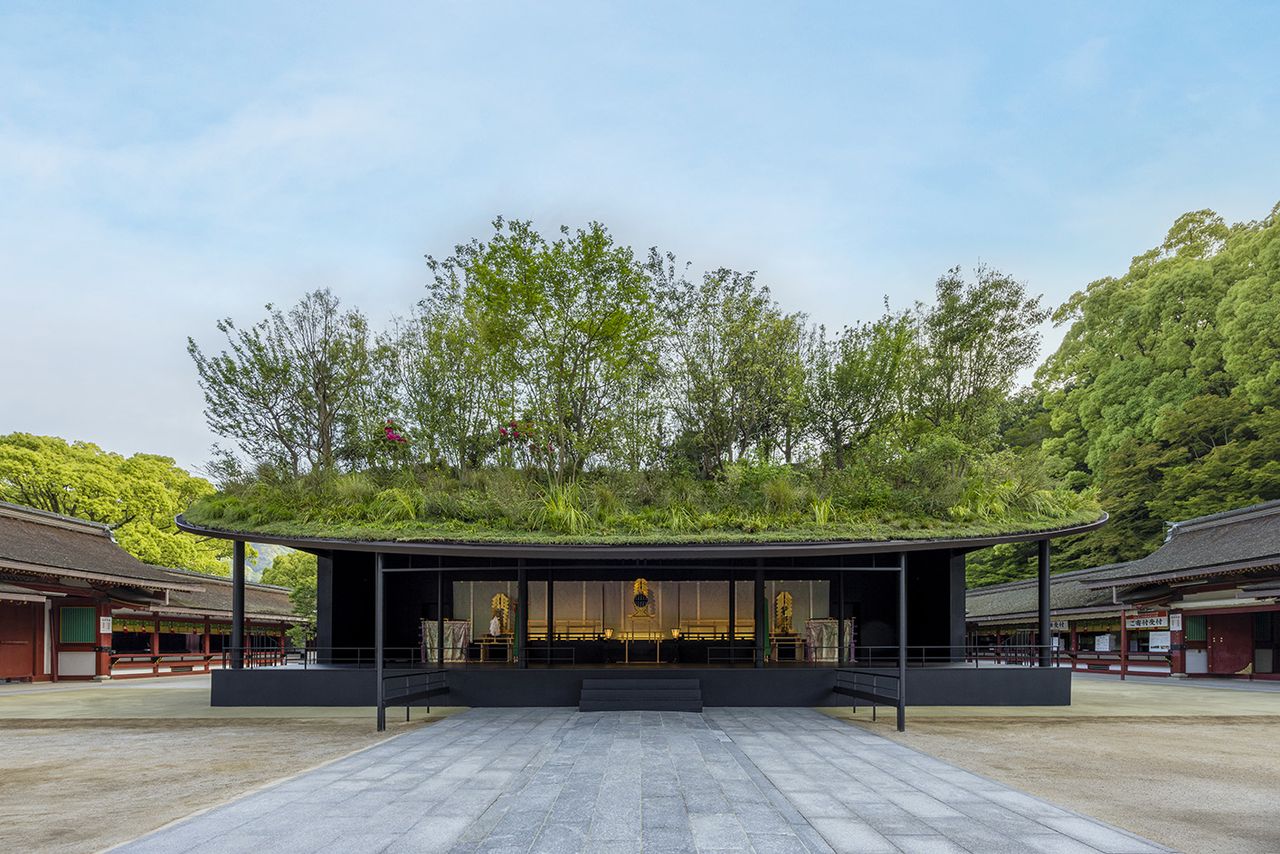
This Sou Fujimoto temporary hall has all the ingredients of a Japanese fairy-tale: a floating forest on an oval roof, a flying plum tree and sacred textiles seen only by a deity. And after three years? It will disappear. This weekend, Dazaifu Tenmangu Shrine, a historic site in lush green Fukuoka in southern Japan, starts a new chapter in its 1,100-year history, with the opening of its project by architect Fujimoto.
The new hall is a minimalist black structure with hints of a modern take on traditional shrine architecture, capped with an elliptical 'floating forest' roof. It features camphor, cherry and maple trees, plus flowering rhododendrons. Inside, sacred textiles are centre stage, designed by Japanese fashion brand Mame Kurogouchi and crafted by generations-old Kyoto artisans – the inner sides not viewable by human eyes, only the shrine’s deity.
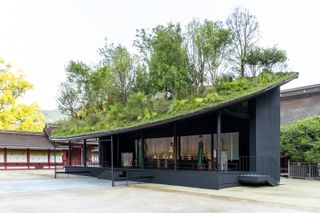
Dazaifu Tenmangu Shrine's Sou Fujimoto temporary hall
The new structure will stand in the inner sanctum of Dazaifu Tenmangu for three years before being dismantled. It will be operational while the main shrine building is renovated for the first time in 124 years.
'With this project, we were faced with the important question of how modern architecture can respond to a history of 1,100 years,' says Fujimoto. 'We thought about the rich nature that surrounds Dazaifu Tenmangu and the traditions of the shrine – and approached the design with a conscious desire to pass these onto the future.'
'We started this over two years ago. It was a challenge creating a temporary building which is both traditional and modern, while also continuing into the future. It’s very simple but it carries a long, important history.'
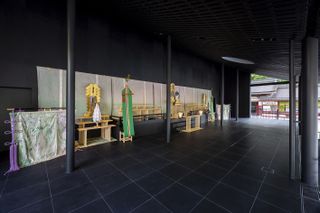
The history of Dazaifu Tenmangu
The shrine was built 1,121 years ago upon the grave of Sugawara Michizane, a legendary ninth century poet, scholar and politician who was exiled to Dazaifu from Kyoto. After his death he was recognised as Tenjin, the Shinto deity of learning, culture and the arts.
Fujimoto’s temporary hall is the latest in more than a millennium of creative activities for Dazaifu Tenmangu. The shrine is historically renowned as a cultural sanctuary for learning, with 10 million visitors a year. It is celebrated for its contemporary arts projects, with installations by Ryan Gander and Simon Fujiwara scattered among its ancient grounds.
Wallpaper* Newsletter
Receive our daily digest of inspiration, escapism and design stories from around the world direct to your inbox.
The shrine’s nature-rich setting is also famously home to a special plum tree, just next to the main hall, which, according to legend, flew there from Sugawara’s Kyoto garden, having missed its exiled owner.
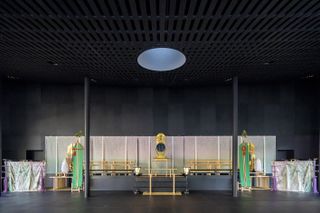
Explaining the floating forest, Fujimoto adds: 'Its concept derives from the legend of the flying plum tree. Plum trees and other plants seem to fly here and dance, creating the roof of the deity’s dwelling. They will change colour as the climate and seasons shift.'
Simplicity underpins the clean-lined form of the matte black steel structure, open on three sides. Elements of traditional shrine architecture are filtered through a contemporary prism – from thin black poles echoing ancient wooden columns to the gentle curvature of its louvered black wood ceiling, inspired by the shrine’s taruki rafters, creating a sense of 'spatial solemnity,' as Fujimoto puts it.
Cut into the roof is a deep circular skylight, resulting in a shaft of light hitting the floor in front of visitors praying at its threshold, the shadows of rooftop trees flickering across the hole’s inner light grey walls.
Spanning 13m across the hall is Mame Kurogouchi’s sacred curtain, called a mitobari, made by 19th century Kyoto-based Kawashima Selkon. Delicately-etched plum tree branches flow across five panels of subtly shifting shades, from airy pale pink to light green. The inner side, out of sight of visitors, was designed for the deity Tenjin.
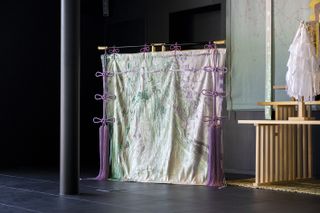
At either end are two textile screens known as kicho, with vividly abstract natural scenes inspired by iris flowers, plum blossoms and an ancient camphor tree at the shrine’s entrance, inside which Maiko Kurogouchi, the brand’s designer, sheltered during a rain shower.
Organic shades of purples and greens wash across the intricate silk textiles, crafted by Kyoto’s kimono textile makers Hosoo, who used natural dyeing ingredients made from the shrine’s camphor and plum trees plus rare gromwell root.
Surfaces are textured with vertical threads typically seen on the reverse side of textiles – an organic blurring of inside and out also found in her fashion collections – evoking a visual sense of rain falling and time flowing.
'When I create my collections, fabric design comes after designing clothes,' Kurogouchi says. 'But this time, everything was about the fabric. It allowed me to work on a larger form of expression. I asked Hosoo to combine modern weaving looms with their own ancient dyeing technique, to create a work that represents the times we live in now. The designs and materials incorporate a plum motif that symbolises the shrine, as well as memories of the chief priest’s family.'
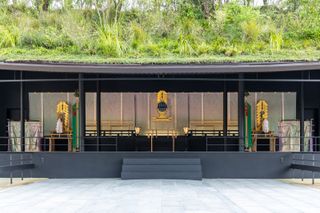
She adds: 'All these elements are merged in the landscape of my memory. I hope visitors will feel the energy and calmness of life in the shrine – and find their own landscape to create unique memories.'
The main shrine hall will undergo extensive renovations, including a new hiwada bark roof and lacquering, before reopening in 2026.
Nobuhiro Nishitakatsuji, the chief priest, adds: 'The temporary hall design, conceived with a deep respect for tradition and the rich nature of the shrine grounds, is very much in harmony with the architectural appearance of the shrine.'
Danielle Demetriou is a British writer and editor who moved from London to Japan in 2007. She writes about design, architecture and culture (for newspapers, magazines and books) and lives in an old machiya townhouse in Kyoto.
Instagram - @danielleinjapan
-
 Patek Philippe brings 15 new timepieces to Watches and Wonders 2025
Patek Philippe brings 15 new timepieces to Watches and Wonders 2025The Swiss manufacturer showcases its intricate complications and elegant designs at the annual trade show with a suite of new models
By Anna Solomon Published
-
 Watches & Wonders 2025: preview Richemont’s latest innovations, on show at the Geneva watch fair
Watches & Wonders 2025: preview Richemont’s latest innovations, on show at the Geneva watch fairDiscover eight enticing timepieces from the luxury group, showcased this week at the Geneva fair
By Simon Mills Published
-
 Masters of midcentury modern design and their creations spotlighted in new book
Masters of midcentury modern design and their creations spotlighted in new book‘Mid-Century Modern Designers’ is a new book from Phaidon celebrating those who shaped the period and their notable creations, from furniture to objects
By Tianna Williams Published
-
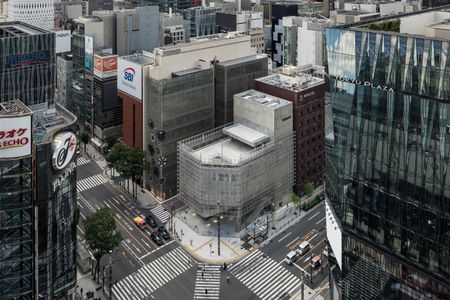 Tour the brutalist Ginza Sony Park, Tokyo's newest urban hub
Tour the brutalist Ginza Sony Park, Tokyo's newest urban hubGinza Sony Park opens in all its brutalist glory, the tech giant’s new building that is designed to embrace the public, offering exhibitions and freely accessible space
By Jens H Jensen Published
-
 A first look at Expo 2025 Osaka's experimental architecture
A first look at Expo 2025 Osaka's experimental architectureExpo 2025 Osaka prepares to throw open its doors in April; we preview the world festival, its developments and highlights
By Danielle Demetriou Published
-
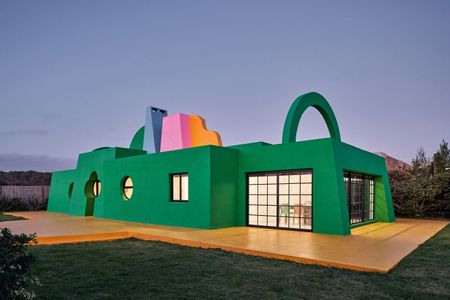 Ten contemporary homes that are pushing the boundaries of architecture
Ten contemporary homes that are pushing the boundaries of architectureA new book detailing 59 visually intriguing and technologically impressive contemporary houses shines a light on how architecture is evolving
By Anna Solomon Published
-
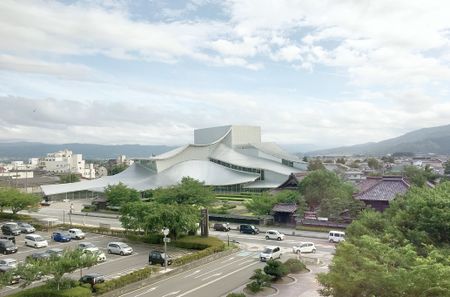 And the RIBA Royal Gold Medal 2025 goes to... SANAA!
And the RIBA Royal Gold Medal 2025 goes to... SANAA!The RIBA Royal Gold Medal 2025 winner is announced – Japanese studio SANAA scoops the prestigious architecture industry accolade
By Ellie Stathaki Published
-
 Architect Sou Fujimoto explains how the ‘idea of the forest’ is central to everything
Architect Sou Fujimoto explains how the ‘idea of the forest’ is central to everythingSou Fujimoto has been masterminding the upcoming Expo 2025 Osaka for the past five years, as the site’s design producer. To mark the 2025 Wallpaper* Design Awards, the Japanese architect talks to us about 2024, the year ahead, and materiality, nature, diversity and technological advances
By Sou Fujimoto Published
-
 Tadao Ando: the self-taught contemporary architecture master who 'converts feelings into physical form’
Tadao Ando: the self-taught contemporary architecture master who 'converts feelings into physical form’Tadao Ando is a self-taught architect who rose to become one of contemporary architecture's biggest stars. Here, we explore the Japanese master's origins, journey and finest works
By Edwin Heathcote Published
-
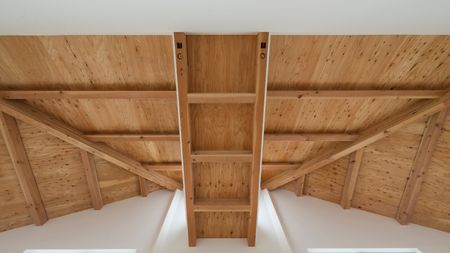 The Kumagaya House in Saitama is a modest family home subdivided by a soaring interior
The Kumagaya House in Saitama is a modest family home subdivided by a soaring interiorThis Kumagaya House is a domestic puzzle box taking the art of the Japanese house to another level as it intersects a minimal interior with exterior spaces, balconies and walkways
By Jonathan Bell Published
-
 Shigeru Ban wins 2024 Praemium Imperiale Architecture Award
Shigeru Ban wins 2024 Praemium Imperiale Architecture AwardThe 2024 Praemium Imperiale Architecture Award goes to Japanese architect Shigeru Ban
By Ellie Stathaki Published